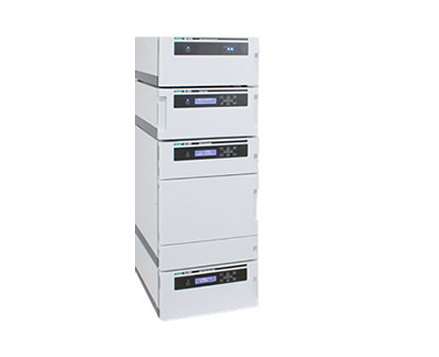High Speed Analysis of Food Coloring in Powder Juice by UHPLC with Photodiode Array Detection
January 5, 2024
Introduction
Food colorings are additives that can be both chemically synthesized and natural. For consumer safety, the uses of many of these food colorings are regulated by the FDA (Food and Drug Administration).
In this application note food coloring in powdered fruit juice was analyzed using Ultra High-performance Liquid Chromatography (UHPLC) with PDA detector with high speed data acquisition (100Hz).
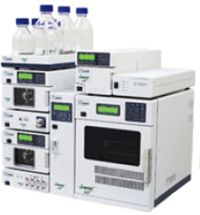
Experimental
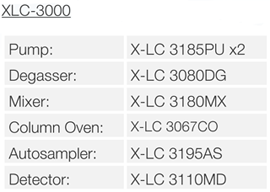
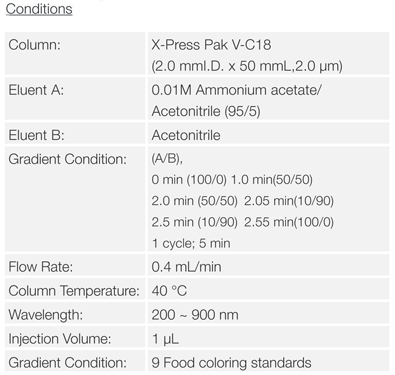
Keywords
620019XRE
Results
The chromatogram of a food coloring standard mixture together with a contour plot is shown in figure 1. Excellent separation of nine commonly used food colorings was obtained in under 2 minutes.
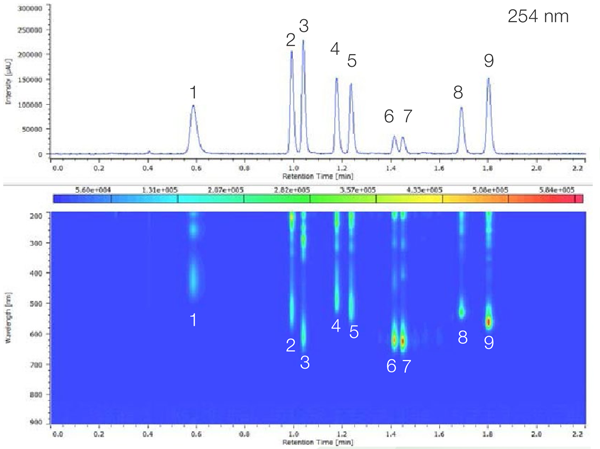
The on-peak spectra of the food coloring standard mixture are shown in figure 2. Representative spectra of each component was obtained and added to a food colorings library in Chrom Nav.

1:Tartrazine (Y4), 2:Amaranth (R2), 3: Indigotine (B2), 4: SunsetYellow FCF (Y5), 5:Allura RedAC (R40), 6: Fast Green FCF (G3), 7: Brilliant Blue FCF (B1), 8: Erythrosine (R3), 9:Acid Red (R106)
The chromatogram of a sample of powdered juice together with a contour plot are shown in figure 3 and the Spectral Library search results of each peak are shown in figure 4.

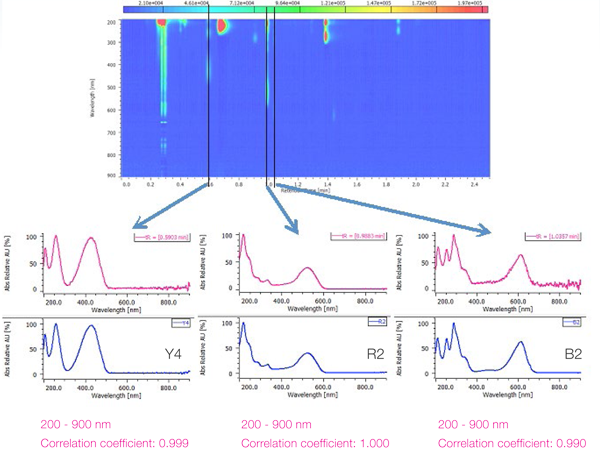
Conclusion
Correlations for both the retention time and the spectral library search (0.99)provide a good match for three of the colorings added to the fruit juice Tartrazine (Y4), Amaranth (R2) and Indigotine (B2). The XLC-3000 offers a fast and reliable system for the analysis of food colorings in a regulated laboratory.
Featured Products:

High Speed Analysis of Food Coloring in Powder Juice by UHPLC with Photodiode Array Detection
Introduction
Food colorings are additives that can be both chemically synthesized and natural. For consumer safety, the uses of many of these food colorings are regulated by the FDA (Food and Drug Administration).
In this application note food coloring in powdered fruit juice was analyzed using Ultra High-performance Liquid Chromatography (UHPLC) with PDA detector with high speed data acquisition (100Hz).

Experimental


Results
The chromatogram of a food coloring standard mixture together with a contour plot is shown in figure 1. Excellent separation of nine commonly used food colorings was obtained in under 2 minutes.

The on-peak spectra of the food coloring standard mixture are shown in figure 2. Representative spectra of each component was obtained and added to a food colorings library in Chrom Nav.

1:Tartrazine (Y4), 2:Amaranth (R2), 3: Indigotine (B2), 4: SunsetYellow FCF (Y5), 5:Allura RedAC (R40), 6: Fast Green FCF (G3), 7: Brilliant Blue FCF (B1), 8: Erythrosine (R3), 9:Acid Red (R106)
The chromatogram of a sample of powdered juice together with a contour plot are shown in figure 3 and the Spectral Library search results of each peak are shown in figure 4.


Conclusion
Correlations for both the retention time and the spectral library search (0.99)provide a good match for three of the colorings added to the fruit juice Tartrazine (Y4), Amaranth (R2) and Indigotine (B2). The XLC-3000 offers a fast and reliable system for the analysis of food colorings in a regulated laboratory.
Keywords
620019XRE

 Download This Application
Download This Application